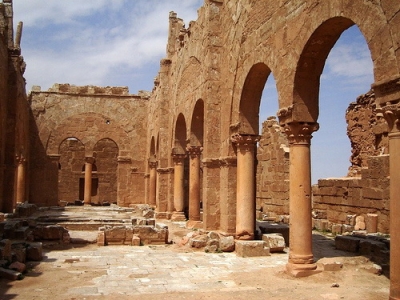Jewel of Syrian Desert and Cradle of Civilizations. AlRasafa, 50km south west of alRaqqa, is one of the most important historical cities in Syria and a precious jewel adorning the Syrian Desert. On its remains ages and civilizations meet and among its ruins the spiritual Christian- Islamic coexistence is incarnated. Therefore much concern is directed to it so that it might restore its glorious past.
History
AlRasafa was mentioned in the ancient Assyrian documents (19th century BC) as Rasappa or Rasaf, and in the classical Greek and Roman eras it prospered as one of the main cities of the Kingdom of Palmyra. Its fame soared high when the Syrian lieutenant Sergius refused to cede his newly embraced faith; Christianity. So, he was sentenced to death in 305AD during the reign of Emperor Diomexian. Soon his tomb, out of the walls of the city, was turned into a mausoleum well known all over the Mediterranean region. Fifteen bishops held an assembly near the tomb and ordered a huge basilica be built to protect his tomb and the tombs of his colleagues Bacchus and Julia. Since that time the Mausoleum became a religious destination for Christian pilgrims and travelers from all over the world. More churches and residences were built nearby turning the region into a metropolis named Sergio Polis and later became a metropolitan bishopric seat.
The city prospered and allured Persians to invade it, but Emperor Justinian and the following Byzantine emperors hastened to protect it. They surrounded it with a defensive wall and supplied it with huge water cisterns so that it can survive sieges. In the fifth century the Arab Christian Ghassanids ruled it, fortified it, created a great economic boom, and built many monuments in it most important of which is the palace of King alMunther, remains of which were lately discovered.
The Golden age of alRasafa started after the Islamic conquest, particularly during the rule of Caliph Hisham Ibn AbdulMalik 724-743 AD, who took it as his headquarter and summer resort preferring it to the Eastern Heer palace in the Palmyran desert. In this time it witnessed a great architectural progress because the Caliph built two huge palaces in it, one of them was discovered lately. The city became a center stage of various activities. It attracted great poets of the time, like alFarazdaq and Jareer, who used to glorify the caliph and his metropolis.
Great historians; Ibn AlA’deem and Abu alFaraj alAsfahani, mentioned it as a large advanced city. When the Umayyad Dynasty was overthrown, the economic status of alRasafa was not affected. On the contrary it continued prosperous for a long time thanks to its distinguished location and its advanced wool and textile industries. In 1048 it was invaded, looted and incinerated by the Qarametas, but it remained a center of religious coexistence where its main mosque and cathedral survived as many historians said.
Structure and monuments
 AlRasafa was built on a rectangular 21 acres area, surrounded by an irregular 3m thick wall supported by circular and rectangular towers. It had four main gates the most beautiful of which is the northern one which has a wonderful design, marvelous columns with decorated capitals, and two protruding towers to defend the gate.
AlRasafa was built on a rectangular 21 acres area, surrounded by an irregular 3m thick wall supported by circular and rectangular towers. It had four main gates the most beautiful of which is the northern one which has a wonderful design, marvelous columns with decorated capitals, and two protruding towers to defend the gate.
The city has many important monuments like the Martyrium located in the main street which crosses the city from its northern gate to the southern one. The street was paved with cobbled lime bricks and covered with red marble tiles. The second important monument is the cathedral of The Cross or the Cathedral of Martyrs where Saints Sergius and Bacchus were buried. South of the cathedral there is an Islamic palace of two levels and a spacious courtyard surrounded by rectangular rooms, one of them is decorated with Arabic inscriptions. Courtyards and cathedrals of the city were always crowded with pilgrims. In the northern courtyard a silver treasure was discovered with coins belonging to 1243- 1259 AD. Four water cisterns of 2m thick walls were built of stones and bricks south of the city to which rain water was drawn from a 500m long dam west of the city. Similar cisterns were also built near the circular tower in the north, the largest of which has a capacity of 16000 Cubic meters of water. Parts of its walls are still covered with glazed pottery. The large size of water cisterns and the huge cathedral are clear indicators of the large number of the population of the city at that time.
In the northern courtyard of the cathedral there is a rectangular mosque with an open air courtyard. The mosque has two niches in the prayer hall, an indicator of religious coexistence between Christians and Moslems and also among Moslem sects.
Excavations:
Thanks to the remarks of the German archaeologist Alfonse Schneider, died in 1951 on his way from alRasafa to Aleppo, archaeological excavations started in this region in 1952 by a German mission headed by Professor Cuckotees and later by Dr. Albert. Since that time excavations continue uninterruptedly.
Haifaa Mafalani

